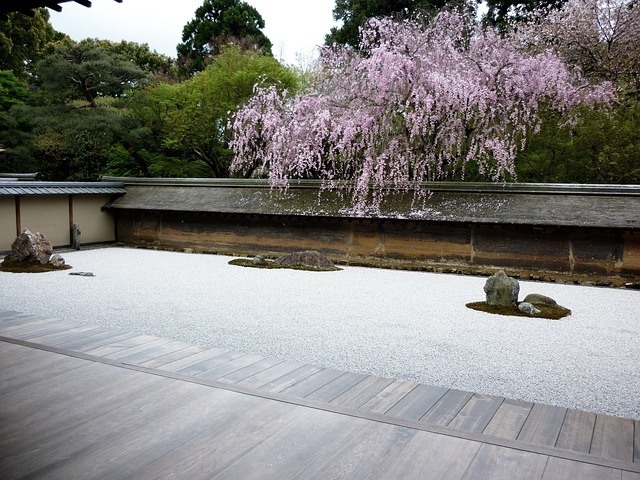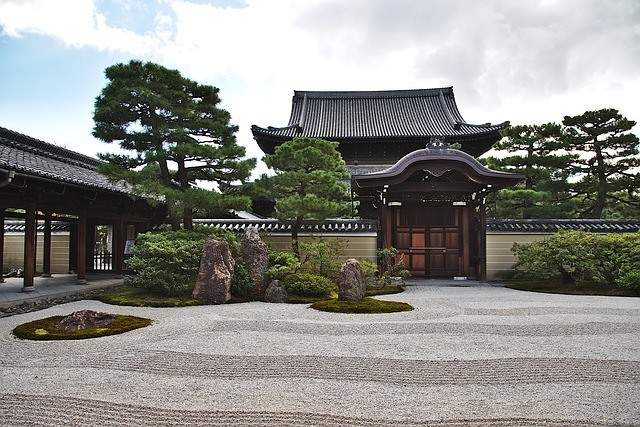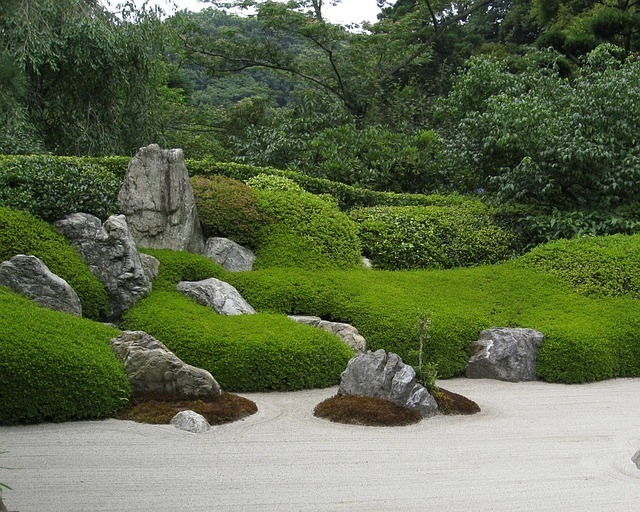Looking to spruce up your garden, but aren’t sure where to start? Then why not turn your regular, old garden into a zen garden?
Zen gardens are uniquely symbolic landscapes that can reflect your inner artistry, as well as provide you with a meditative experience. These arrangements are more than just beautiful – they’re functional!
Let’s take a look at what Japanese zen gardens are, the history and origins behind them, and how to make a zen garden of your very own.
Contents
What is a Zen Garden?
Zen gardens are sometimes better known as Japanese rock gardens. These stylized, dry landscapes are mainly composed of rocks, moss, pruned trees and bushes, and layers of gravel or sand carefully raked to represent the flow of water.
The lack of plants around this garden is meant to emphasize the spiritual importance of the way you arrange the rocks, trees, moss, and gravel or sand. As a plus, this means far less maintenance for you than with typical gardens.
The placement of these objects is deeply rooted in Zen Buddhist teachings and philosophies, many of which date back centuries ago. Let’s take a closer look at that.
History and Origins
Zen gardens were first created in Zen Buddhist temples in Kyoto, Japan, during the Muromachi Period.
These gardens were essentially shallow sandboxes filled to the brim with either sand or gravel and later decorated with larger rocks of various shapes and sizes.
Put together, the large rocks and surrounding sand or gravel are meant to represent islands in the sea.
The upkeep of the sand or gravel is an especially important process. Creating the impression of ocean waves through raking is often used as an aid to meditation, especially about the true meaning of life.
As such, keeping a zen garden was meant to be a highly spiritual experience, and it is still considered one today.
Zen Garden Ideas
If you aren’t sure how to go about creating your very own zen garden, the Spruce is a fantastic website to help. The site offers plenty of home improvement ideas to its users, including several articles about how to create the perfect Japanese zen garden.
But why wait? Here are great ideas you can try out below!
Japanese Zen Garden
The selection and placement of your larger rocks is – by far – the most important part of creating a Japanese rock garden.
In fact, there are certain rules you must follow in order to respect this ancient gardening tradition.
Choosing Stones
The first known manual of Japanese gardening is called the Sakuteiki (or “Records of Garden Making”). It laid out very specific rules for choosing and placing stones in a zen garden, warning those that do not heed these rules will suffer great misfortune.
Rocks are typically classified as either tall vertical, low vertical, arching, reclining, or flat among Japanese gardeners. These classifications are made to symbolize different aspects of nature, which will be further discussed in the “Zen Rock Garden” section below.
The type of rock chosen is just as vital as its shape. For instance, you must use igneous rocks, or rough mountain rocks that have sharp edges, to symbolize mountains. The borders of your Japanese zen garden should be smooth sedimentary rocks to keep in the gravel or sand.
The Sakuteiki also states that your stones should:
- Vary in color, shape, and size from one another.
- Not have bright colors that could distract the viewer from the whole picture.
- Have grains that generally run in the same direction.
Placing Stones
Once you have chosen your rocks, you need to be very careful about their placement around your garden. The harmony of the overall rock composition is meant to give its owner a sense of peace and tranquility.

All your stones must be placed with their best sides shown at all times and at all angles. This means that if a stone has an ugly-looking top, you must place it in a way that hides that fault, even if it leans at an odd angle.
Stones are rarely placed in simple, straight lines or in symmetrical patterns around your typical zen garden. The most common rock arrangement consists of a single group or even several groups – of three rocks each.
Many Buddhists place two small rocks on either side of a tall vertical rock to represent Buddha and his two attendants. However, the placement of rocks is not as rigid as these rules would have you believe.
A new “rule” was invented at the end of the Edo period: suteishi, which are discarded or “nameless” rocks placed at random to add a sense of spontaneity to the garden.
Adding Plants
Plants must be kept to an absolute minimum in a zen garden, as the emphasis is more on the stones and their placement around the garden.
You can find a list of plants to keep in a zen garden here.
Zen Rock Garden
The symbolism behind the stones is one of the most important (if not the most important) design elements in the creation of a Japanese rock garden.
- Vertical stones (or taido rocks) are often used to represent trees (or the element of wood).
- Flat, horizontal stones (or shintai rocks) represent flowing water.
- Arching stones (or shigyo rocks) represent fire.
- Low or reclining stones (or reisho and kikyaku rocks respectively) represent metal and the earth.
Feel free to experiment with different combinations, such as:
- A tall vertical rock (wood) with a reclining rock (earth).
- A short vertical rock (metal) and a flat rock (water).
- A tall vertical rock (wood), a reclining rock (earth), and a flat rock (water).
Whichever arrangement you choose, just be sure that you balance the number of vertical and horizontal rocks in your zen garden.
You can also use your large stones to mimic other natural formations.

Karetaki
Your zen garden should absolutely lack a pond or body of water. If you really want to include a water-like feature, then you can design a karetaki, or dry waterfall.
All that’s necessary is to arrange your stones and sand or gravel into a waterfall-like shape. Typically, the waterfall’s cascade is represented through a tall, standing bluestone.
You can then create a karenagare, or raked sand river, to mimic a stream at the base of your waterfall.
Karesansui: Rock Sculptures
Depending on the size of your stone, you can use it to symbolize a mountain, an island, or a welcoming post if it’s placed at the entrance of your garden.
You can also create a kogetsudai, or gravel mountain, out of gravel or sand by shaping the substrate into a tall cone to represent Mount Fuji (or another mountain).
You can also create a simple bridge or pathway made of stone through your garden. This path can add a sense of distance to your zen garden, and you can use them as a focal point to aid meditation as well.
This video goes into more detail on how to make a zen garden.
Small Zen Garden
While most people may think all zen gardens must be grand, sweeping places, this is actually incorrect. Zen gardens are refuges unrestricted to their size or location, and can, in fact, be any size the owner wants – so long as it provides them some form of peace in that space.
Even keeping a mini zen garden on your desk may help increase your concentration and reduce stress.
You might be unable to place as many stones or plants in this smaller zen garden, but arranging your chosen flora and stones, as well as drawing new patterns in your gravel or sand, can be just as meditative as keeping a much larger garden.
In fact, this tiny garden could be just the solace you need from an overwhelming workload throughout the day.
Zen Sand Garden
Using sand as opposed to gravel in your zen garden can create an interesting symbolic contrast.
The fluid quality of sand expresses a sense of changeability that juxtaposes the solid, timelessness of stone. It can also symbolize an empty mind (as opposed to one full of negative thoughts), or, when raked in swirls, represent how water laps at the edges of stones and islands.
Depending on how they are raked, these swirls can depict either raging or gentle waves. In much broader terms, sand may also symbolize the ocean surrounding the island of Japan.
In essence, a zen sand garden provides an interesting aesthetic, as well as a tangible balance to the rigidity of stones you choose to use.
How to Make a Zen Garden
While zen gardens may look simple to create and maintain, they are anything but. They may seem low-maintenance on the surface, due to the lack of plants, but the raking process (especially for those who opt to use sand over gravel substrate) requires a surprising amount of concentration and skill.
There’s no mandatory upkeep, but the meaning behind these gardens lends itself to hard work.
This is also not a garden for those who want to grow more extravagant flora or keep much flora in general. Do keep these details in mind before you commit to developing a giant zen garden in your backyard.

Supplies and Materials
- Tape measure.
- Fencing (optional).
- Shovel.
- Stakes.
- String.
- String level.
- Steel garden rake.
- Tamper.
- Edging stones.
- Rocks of various sizes and shapes.
- White gravel or sand.
- Wooden Zen rake.
- Hoe.
- Landscape fabric.
Method
- Mark a rectangular, flat area in your backyard to create your zen garden. A 12 x 18-foot rectangle may suffice on a smaller property. You must also take into account the appropriate sunlight and watering requirements of your plants if you plan to grow some in your garden as well.
- A traditional zen garden is a walled-in space due to its personal, meditative nature. Most people, however, might not want to construct a large stone wall just for this one spot. In that case, you can invest in some cheaper lattice fencing instead, so as to achieve nearly the same effect. Of course, this would then be a separate project you need to undertake before you start on your zen garden, so be sure you plan your time accordingly. Just be sure your resulting gate is wide enough for you to bring your zen garden supplies in later.
- Clear your rectangular space of any plants, weeds, stones, or other debris in the way.
- Use your shovel to remove a few inches of soil from your marked area.
- Hammer your stakes into the ground at each corner, tying your string between them to check the level with your sting level.
- Use the steel garden rake to rake out any uneven spots until the ground is flat.
- Tamp down the soil.
- Place your edging stones. These stones will keep your gravel or sand inside.
- If you plan to use any large stones, or compile your gravel or sand together to represent mountains or islands, then be sure you dig a large enough hole for each “mountain” or “island” you erect. You should also dig holes for any plants you install.
- Place your larger rocks and plants in their respective holes. The “mountain” rocks should be buried most of the way in the hole.
- Place your landscape fabric over the soil. Make sure you cut holes in the fabric to accommodate your “mountain” rocks and plants.
- Arrange your rocks together in a way you like best.
- Scatter a few inches of your gravel or sand, using your hoe to distribute it evenly. Finally, you can use your wooden Zen rake to create patterns in the substrate.
This video shows another example of a zen garden ideas.
Conclusion
Japanese zen gardens are among the most fascinating and tranquil garden ideas you can develop.
Not only is the creation and upkeep of your Japanese rock garden meant to be a meditation in its own right, but it will also make your backyard much more unique than your neighbor’s.
Just be mindful of this gardening style’s cultural and religious origins, and you should be creating a more tranquil backyard in no time.
What are your favorite zen garden ideas?






